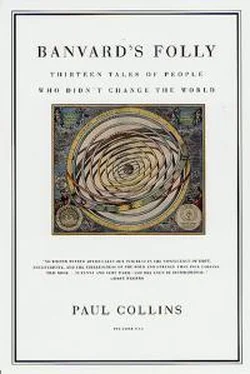Sudre created five classes of words for his Solresol vocabulary, composed respectively of one to five syllables. Sensibly enough, the one-syllable words--of which there can only be seven--are for the most common uses: do--no, not re--and mi--or fa--at, to so--if la--the si--yes The forty-nine possible permutations of two-syllable words mostly cover pronouns like "I" (dore) and particles like "this" (fami). They also include
some of the more common phrases of speech, like "good night" (misi). (since Solresol is reversible, you'd be right in guessing that the word for "good day" is simi.) The 336 permutations of three-syllable words are wholly given over to common conversational terms, like "rain" (sisido), "husband" (misifa), and "want" (fasifa).
A traveler mastering the first 392 words of Solresol could probably express his needs at least as well as a small child does in a native tongue--and with an equally amusing melodiousness. But as any good numbers runner or state lottery knows, once you get to four or five variables, the number of permutations rises dramatically. The four-syllable vocabulary (with 2,268
words) and the five-syllable vocabulary (with 9,072 words) dwarf the rest--in fact, although his Solresol labors lasted forty years, Sudre never did make it to the five-syllable words.
Given the enormous number of four-syllable words, some system of organization was needed. Keeping the language's musical basis in mind, Sudre established a system of keys for these longer words where the first syllable indicates its subject matter. Thus doredofa ("head") is much closer in meaning to doredosi ("hair") than to a word starting in a different key, like fasiredo ("railroad"). But with hundreds or thousands of words present in even just one key, the keys are necessarily broad:
do--Physical and Moral Aspects of
Humanity re--Family, Household, and Dress mi--Human Actions fa--Agriculture, War, and Travel sol--Arts and Science la--Industry and Commerce si--Government, Law, and Society
A musician might protest that these words are actually in different modes, not keys. But Sudre was not writing for musicians. He always stressed that Solresol didn't require any musical training at all--and so the misnomer "key"
stuck.
Sudre tried to apply logical design to grammar. This differentiated Solresol from such exasperating languages as English, which has a bastard grammar of Middle German, Latin, and French. Word order in Solresol is simple: subject-verb-object, and noun-adjective. Plurals are indicated by lengthening the first consonant of the final syllable: saying "Doremmmi" for doreme would indicate that you mean "days" and not the singular "day." And finally, parts of speech are indicated by which syllable is stressed: redomido--to slander (no accent) RE-DOMIDO--SLANDER reDO-MIDO--SLANDERER
redoMI-DO--SLANDEROUS redomiDO--SLANDEROUSLY
You'll notice there's just one verb--the infinitive "to slander." That's because there are no verb tenses to memorize. Instead, you use a word before the verb (usually a double syllable like sisi or rere) to indicate past, present, and future, and so forth: an innovation that would delight any student who's ever had to slog through index cards crammed with verb conjugations.
Sudre's system was clever--but could he actually create an entire lexicon from scratch? Pondering the size of the task before him, Sudre often quoted one colleague's comment on it: "I am not sure that God allowed it, but it is not forbidden for the human brain to try it."
Aside from the initial act of conjuring thousands of words, Sudre also needed to create bilingual dictionaries in every major language in order for Solresol to gain usage. He planned to single-handedly write Solresol dictionaries in
twelve languages: French, English, German, Portuguese, Italian, Spanish, Dutch, Russian, Turkish, Arabic, Persian, and Chinese.
On July 23, 1833, he invited the press to the Royal Academy of Fine Arts to witness public demonstrations of French-Solresol translation. In his usual fashion, he had students listen to Solresol phrases from his violin, whereupon they translated them into French with astonishing speed. The following June the Paris newspaper La Quotidienne asked Sudre for a private demonstration.
Sudre showed up in the newspaper offices with two young students, clicked open the latches of his violin case, and asked to take dictation from the newspaper staff. The paper's editor picked up his pen and scratched out a single word onto a slip of paper: "Victoire!" Sudre played a few notes on his violin. His students, in another room, dutifully translated this into perfect French.
To the staff's bewilderment, Sudre then asked them to give him words in English, German, Spanish, Italian, Arabic, or Chinese-because he had already completed six dictionaries. It was, one editor later wrote, "the only fifteen minutes of my life that I seriously regretted not knowing Arabic or Chinese."
Sudre's reputation, and that of his new language, grew with each performance.
When he arrived in Brussels just three months later, articles lauding the
"Prophet of Sound" and his new language preceded his appearances; afterward, they marveled at the fact that Sudre was now easily rendering multiple languages into Solresol onstage. Sudre was a confident performer: to start his shows, he'd read aloud from government reports on his inventions, and as an encore he would sometimes sing his own original compositions to the audience.
By the time Sudre returned to Paris, he had become a household name, the subject of newspaper articles and satirical spoofs alike. Composers like Hector Berlioz were attending his shows and pleading with the government to hire Sudre before some foreigner did. The optimism among musicians that Sudre and his decades of effort might have raised their vocation to a new height was perhaps best expressed in a February 5, 1835, article in the music journal Le Pianiste: "When it comes to posterity, that which M. Sudre already belongs to, we are assured that he will be most appreciated, and that, if we have elevated a statue of Gutenberg, the inventor of printing, we will find it just later to erect one to the inventor of the musical language."
Just weeks after Sudre was championed in print as the next Gutenberg, he demonstrated an innovation that other constructed language creators had never even attempted: communication with the deaf and blind. At a performance on the night of February 22, Sudre dramatically wrapped a handkerchief over his eyes and asked that one of his students be silently given a phrase to translate.
His pupil then walked over to the blindfolded teacher and delicately pressed his fingers into Sudre's palm. Sudre opened his mouth--and to the crowd's disbelief, out came the precise words that had been written down.
What Sudre had done was transpose the seven notes of the scale to positions on his hand: By simply tapping away at the other person's palm, a blind man could now communicate with a mute. Such an invention, in an era where the handicapped were generally left to rot in institutions, was an extraordinary advance. And it was both a strange and strangely touching sight on stage--a boy and a man, hands clasped together, talking in earnest silence.
Now the Gutenberg comparisons were echoing throughout the Parisian press.
Sudre arranged for one final performance at the Paris city hall--and then, ominously, he was to go off to England. "We do not believe that a discovery has ever received more impressive testimonies," one newspaper complained, "and we refuse again to believe that to gather fruits, the inventor should be obliged to leave the country." The British press was no less astonished at
this fact. After his arrival in London in July 1835, Mechanic's Magazine marveled, "In spite of the serious and important reports we have received in his favor, he has only received feeble encouragement from his own country. We hope he will find a better fortune among us."
Читать дальше











